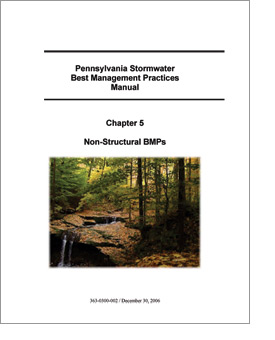
BMP Manual - Chapter 5

SUMMARY: The terms “Low Impact Development” and “Conservation Design” refer to an environmentally sensitive approach to site development and stormwater management that minimizes the effect of development on water, land and air. This chapter emphasizes the integration of site design and planning techniques that preserve natural systems and hydrologic functions on a site through the use of Non-Structural BMPs. Non-Structural BMP deployment is not a singular, prescriptive design standard but a combination of practices that can result in a variety of environmental and financial benefits. Reliance on Non-Structural BMPs encourages the treatment, infiltration, evaporation, and transpiration of precipitation close to where it falls while helping to maintain a more natural and functional landscape. The BMPs described in this chapter preserve open space and working lands, protect natural systems, and incorporate existing site features such as wetlands and stream corridors to manage stormwater at its source. Some BMPs also focus on clustering and concentrating development, minimizing disturbed areas, and reducing the size of impervious areas. Appropriate use of Non-Structural BMPs will reflect the ten “Principles” presented in the Foreword to this manual, and will be an outcome of applying the procedures described in Chapter 4.

BMP Manual Chapters
- BMP Manual - Introduction
- BMP Manual - Chapter 1
- BMP Manual - Chapter 2
- BMP Manual - Chapter 3
- BMP Manual - Chapter 4
- BMP Manual - Chapter 5
- BMP Manual - Chapter 6
- BMP Manual - Chapter 7
- BMP Manual - Chapter 8
- BMP Manual - Chapter 9
- BMP Manual - Appendix A
- BMP Manual - Appendix B
- BMP Manual - Appendix C
- BMP Manual - Appendix D
- BMP Manual - Glossary

